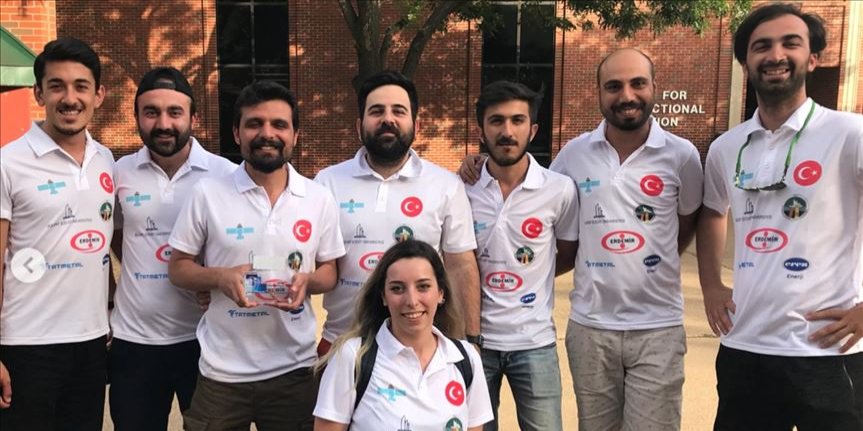
Astronomers from the University of Göttingen in Germany have discovered two, and possibly three, super-Earth exoplanets orbiting the nearby red dwarf star Gliese-887.
Artist’s concept of Gliese 887b and Gliese 887c orbiting their red dwarf star. Image via Mark Garlick/ University of Göttingen .
Details of the peer-reviewed findings have been published in the June 26, 2020, issue of the journal Science .
The two planets are orbiting the nearby red dwarf star called Gliese 887 (also known as GJ 887 or Lacaille 9352 ), which is only 11 light-years away. While not quite within the habitable zone, where liquid water could exist on the surface of rocky worlds, the planets are close to the inner edge of the zone. According to the abstract of the new paper:
Other things to check out:
Remnant Core of Giant Planet Found Orbiting Sun-Like Star TOI-849 | Astronomy | Sci-News.com
An artist's impression of a Neptune-sized exoplanet. Image credit: Mark Garlick / University of Warwick.
* * *
Also catalogued as TIC33595516 and TYC 6431-1158-1, the star is slightly smaller and less massive than the Sun and is 6.7 billion years old.
TOI-849b has a radius smaller than Neptune's but an anomalously large mass of 39.1 times that of Earth, nearly half the mass of Saturn.
The object is 3.4 times bigger than our home planet and its mean density is 5.2 g/cm 3 , similar to Earth's, making it the densest Neptune-sized planet discovered so far.
Giant exoplanets found to orbit star in 'gravitational dance' - BBC Science Focus Magazine

The objects were spotted by astronomers who are part of an international consortium known as Wide Area Search for Planets (WASP).
The planets, named WASP-148b and WASP-148c, orbit a Sun-like star about 800 light-years away, in the constellation of Hercules.
According to the scientists, these giant objects are able to "feel each other's gravity", which causes the faster-orbiting WASP-148b to speed up and slow down as it overtakes WASP-148c on the inside.
University Of Chicago Astrophysicists Discover New Planet | WBBM-AM

"AU Mic is a young, nearby M dwarf star. It's surrounded by a vast debris disk in which moving clumps of dust have been tracked, and now, thanks to TESS and Spitzer, it has a planet with a direct size measurement," co-author Bryson Cale told NASA, a doctoral student at George Mason University. "There is no other known system that checks all of these important boxes."
Check out this next:
NASA Space Station On-Orbit Status 1 July, 2020 - Spacewalk Completed - SpaceRef
NASA astronaut and Expedition 63 Flight Engineer Bob Behnken (upper left) works during a six-hour and one-minute spacewalk to swap an aging nickel-hydrogen battery for a new lithium-ion battery on the International Space Station's Starboard-6 truss structure. Protruding horizontally from the truss are the Thermal Control System radiators that dispel heat generated by the orbiting lab's power systems. Credit: NASA. (July 1, 2020)
* * *
During the six hour and one-minute spacewalk, the two NASA astronauts completed half the work to upgrade the batteries that provide power for one channel on one pair of the station's solar arrays. The new batteries provide an improved and more efficient power capacity for operations.
Turkish space team to send mini satellite into orbit by end of 2020 | Daily Sabah

A team of Turkish engineering students will send a miniaturized satellite into space by the end of the year.
"We started working on the PocketQube in 2016, then a newly developed standard in space technology, and developed Turkey's first PocketQube satellite, Grizu-263A," Aytaç Dursun, head of the Grizu-263 Space Team, said.
"The satellite will be sent into orbit in December using SpaceX's Falcon 9 rocket, launched from the Cape Canaveral Space Launch Complex in the U.S.," he told Anadolu Agency (AA).
ASTRONOMY: Comets and asteroids and meteoroids, Oh my! | Local News | qctimes.com

• Comet – A mass of ice, rock and dust which often has a tail. The tail is made up of water vapor, dust and various gases which vaporize and grows as it gets closer to the sun.
• Asteroid – A body made up of metallic and non-metallic rock orbiting the sun and usually in the asteroid belt between Mars and Jupiter.
• Meteoroid – Often an asteroid fragment that although orbiting the sun, will make its way to entering Earth's atmosphere.
Cluster of international satellites ready for ride into orbit on Vega rocket – Spaceflight
Debuting a two-tier structure designed to accommodate dozens of small satellites on a single mission, an Italian-made Vega rocket is set for liftoff Saturday night from the northeastern coast of South America on a flight to demonstrate European industry’s answer to growing rideshare launch demand.
Funded by the European Space Agency, the adapter structure was designed and manufactured in the Czech Republic and Italy. Engineers say it can be reconfigured in different arrangements to allow for launches with varying numbers of CubeSats and larger minisatellites as large as a refrigerator.
Happening on Twitter
@stlcao Kimberly Gardner, one of four Democrats running for St. Louis circuit attorney in the Aug. 2 primary, is ta… https://t.co/2GKSSFkIHC Cernovich (from Orange County, California) Mon Jun 29 20:06:28 +0000 2020
No comments:
Post a Comment